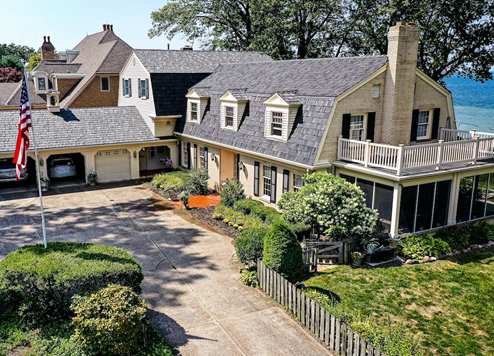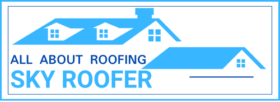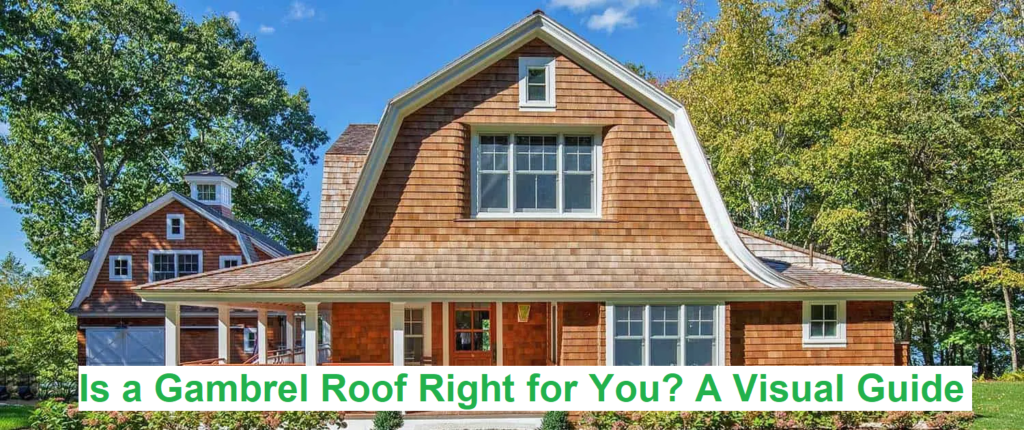Choosing the right roof style for your home is an essential step that affects both appearance and functionality. The gambrel roof is a classic style often associated with barns but is now popular in residential homes due to its unique design and space-maximizing features. In this guide, we’ll explore Is a Gambrel Roof Right for You? how it compares to other roof styles, the pros and cons, types, costs, and whether it’s the right fit for your home.
Need expert help with your roof? Contact Sky Roofer today for a free quote and professional advice on choosing the right roof trusses!
- What is a Gambrel Roof?
- The Basics of Gambrel Roof Design
- Gambrel vs. Gable Roof
- Gambrel vs. Mansard Roof
- The Diversity of Gambrel Roof Designs
- Pros and Cons of a Gambrel Roof
- Common Materials for Gambrel Roofs
- Gambrel Roof Cost Breakdown
- Gambrel Roof Installation Guide
- Is a Gambrel Roof Right for You? Key Considerations
- FAQs about Gambrel Roofs
- Conclusion
What is a Gambrel Roof?
A gambrel roof is a two-sided roof style featuring a steep lower slope and a gentler upper slope on each side. This design maximizes attic or upper-level space, creating a distinctive barn-like appearance. Traditionally used for barns, gambrel roofs have become a popular option for homes seeking extra storage or attic space.

The Basics of Gambrel Roof Design
The gambrel roof is designed with two slopes on each side. The lower slope is steeper and provides increased headroom, while the gentler upper slope helps with water drainage. Gambrel roofs are typically framed with trusses or timber, offering a robust and stable structure.
Gambrel vs. Gable Roof
When comparing a gambrel roof with a gable roof, a key difference is the slope design. While a gable roof has a single slope on each side, a gambrel roof has two slopes, which allows for more space inside. Gable roofs are simpler and more common, especially in areas with heavy snowfall, as they shed snow efficiently. Gambrel roofs, however, offer more space and a unique look, making them ideal for those who prioritize both functionality and aesthetics.

Gambrel vs. Mansard Roof
A mansard roof is similar to a gambrel roof in that both have multiple slopes. However, the mansard roof has four sides, each with two slopes, giving it a more elaborate, boxy appearance. Mansard roofs are commonly seen on French-inspired architecture and offer the benefit of a full attic or extra living space. Gambrel roofs are typically simpler in design, with only two main sides, making them easier to build and more affordable, while still providing additional space.

The Diversity of Gambrel Roof Designs
Gambrel roofs come in various designs, allowing homeowners to customize their appearance:
- Classic Barn Gambrel: The traditional style often seen on barns, with steep lower slopes and gentle upper slopes.
- Colonial Gambrel: A more refined look with symmetrical slopes, popular in Colonial-style homes.
- Dutch Gambrel: Known for its extended eaves and overhang, adding extra shade and protection from the elements.
- Modern Gambrel: A contemporary twist, featuring metal or mixed materials for a sleeker appearance.
Each design offers unique benefits and can be tailored to fit the aesthetic and functional needs of your home.

Pros and Cons of a Gambrel Roof
Understanding the pros and cons of a gambrel roof can help you determine if it’s right for you:
Pros:
- Maximized Interior Space: Provides more headroom, ideal for storage, lofts, or even additional living spaces.
- Efficient Water Runoff: The design allows rain and snow to run off easily, reducing the risk of leaks.
- Unique Curb Appeal: Adds a charming, rustic touch that enhances the visual appeal of your property.
- Cost-Effective Construction: With fewer roof sections to construct, gambrel roofs can be more budget-friendly.
Cons:
- Higher Wind Susceptibility: The broad, flat areas can make gambrel roofs more susceptible to wind damage.
- Regular Maintenance: The multi-slope structure may require frequent inspections and maintenance.
- Complex Repairs: Damage can be more challenging to repair, potentially leading to higher maintenance costs.
Common Materials for Gambrel Roofs
Selecting the right material is key to ensuring durability and matching the style of your home:
- Asphalt Shingles: Affordable and versatile, a popular choice for residential gambrel roofs.
- Metal Panels: Known for durability and weather resistance, metal roofing can be an excellent choice for gambrel roofs.
- Wood Shingles or Shakes: Ideal for a rustic look, though they may need more frequent upkeep.
- Slate or Clay Tiles: These materials add elegance and durability, though they are heavier and may require reinforced support.
Gambrel Roof Cost Breakdown
Costs vary depending on factors like materials, labor, and roof size. Here’s a general cost breakdown:
- Installation: Basic installation costs range from $8,000 to $20,000, depending on size and materials.
- Material Costs: Asphalt shingles cost about $1-$4 per square foot, while metal roofing can range from $5-$15 per square foot. Premium materials, such as slate or wood, will cost more.
- Additional Costs: Structural reinforcements, custom designs, and routine maintenance are factors to consider when estimating costs.
Gambrel Roof Installation Guide
Installing a gambrel roof is a complex process that requires careful planning, precise measurements, and high-quality materials to ensure long-lasting durability. Due to its distinctive two-slope design, it’s recommended to hire a professional roofer for proper installation. However, understanding the basic steps can provide valuable insight into what the installation involves and how to ensure it meets your needs. Here’s a step-by-step breakdown of the typical process involved in gambrel roof installation:
1. Design and Planning
- Blueprints and Permits: Start by consulting with a roofing professional or architect to create a detailed blueprint of the gambrel roof structure. Accurate measurements are crucial for the dual slopes of a gambrel roof, as the lower, steeper slope requires precise framing. Additionally, securing the necessary building permits from local authorities ensures compliance with building codes.
- Material Selection: Choose materials that align with your climate and budget. Asphalt shingles are affordable and versatile, while metal roofing offers excellent durability and weather resistance. Opting for high-quality materials can increase the roof’s lifespan and reduce future maintenance costs.
2. Laying the Framework
- Building Trusses: The framework or skeleton of the gambrel roof is typically made with timber or trusses, designed to support the unique two-slope structure. Trusses are prefabricated in many cases to ensure stability, which helps with faster installation. Trusses support the lower and upper slopes, creating the foundation for each section of the roof.
- Constructing the Lower Slope: The lower slope is the steeper section of the gambrel roof, designed to maximize interior space and headroom. Builders start by securing the trusses and then add bracing to support the steep angles, reinforcing the roof’s integrity.
- Adding the Upper Slope: Once the lower slope is complete, the gentler upper slope is constructed. This slope enhances water drainage, reducing the risk of leaks. It’s crucial to ensure that both slopes align perfectly to avoid gaps or structural issues.
3. Applying Roofing Materials
- Waterproofing and Insulation: To protect the roof against leaks and extreme weather, apply a layer of waterproofing material, such as underlayment, before adding the final roofing materials. This step is particularly important for gambrel roofs in areas with heavy rainfall or snow, as it helps prevent moisture from seeping into the roof’s framework.
- Installing the Final Roofing Material: After waterproofing, the final roofing material is added. For gambrel roofs, common options include asphalt shingles, metal panels, or even wood shingles. Each material is installed according to its type—for instance, shingles are overlapped to provide maximum coverage, while metal panels are fastened tightly to avoid uplift during high winds.
4. Adding Essential Components
- Ventilation and Insulation: Proper ventilation is crucial for gambrel roofs, as it prevents moisture buildup and reduces heat retention. Ridge vents, soffit vents, or gable vents are commonly installed to ensure airflow. Insulation also helps with temperature control, making the home more energy-efficient.
- Drip Edges and Flashing: Drip edges and flashing are essential components that protect the edges and joints of the gambrel roof from water intrusion. Flashing is applied around chimneys, vents, and valleys, where water could potentially seep in, while drip edges are installed along the eaves and rakes to guide water away from the roof.
- Adding Gutters: Gambrel roofs benefit from a well-designed gutter system to manage water runoff, especially during heavy rain. Gutters prevent water from pooling at the base of the home, which can protect the foundation from water damage.
5. Final Inspections and Quality Checks
- Structural Integrity Check: Before considering the installation complete, roofing professionals perform a final inspection to ensure structural stability. This includes checking for any gaps, loose materials, or misalignments.
- Weatherproof Testing: To confirm that the roof can handle local weather conditions, installers may test areas prone to leaks, such as seams and edges. Addressing minor issues during this phase can help prevent costly repairs in the future.

Is a Gambrel Roof Right for You? Key Considerations
Deciding on a gambrel roof involves factors like climate, budget, and personal preference. While gambrel roofs offer spacious interiors and distinctive style, they may not be ideal for areas with high winds. If you value additional attic space, unique aesthetics, and cost-effective construction, a gambrel roof could be a perfect fit.
FAQs about Gambrel Roofs
- What are the benefits of a gambrel roof?
- Gambrel roofs provide extra attic space, a unique look, and efficient water runoff.
- How do I choose the best material for my gambrel roof?
- Consider climate, budget, and the roof’s style. Metal offers durability, while asphalt shingles are affordable.
- Can gambrel roofs withstand heavy snowfall?
- Yes, but using durable materials like metal and adding structural support will help manage snow load.
- Are gambrel roofs costly to maintain?
- While they require regular inspections, proactive maintenance can help manage costs.
- Are gambrel roofs suitable for hurricane-prone areas?
- Gambrel roofs may not be ideal in areas with frequent high winds due to their broad, flat surfaces.
Conclusion
A gambrel roof can add both function and charm to your home, providing extra living or storage space and a timeless aesthetic. By understanding its design, pros and cons, materials, and costs, you can make an informed choice about whether this style suits your needs. Whether you’re inspired by the classic barn look or the practicality of added space, the gambrel roof could be the perfect addition to your property.
Looking for Gambrel Roof Right for You? Learn more about our services and contact Sky Roofer for expert guidance.



